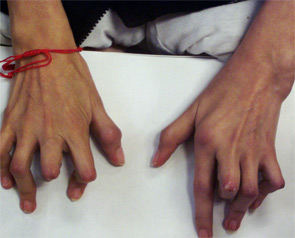The magnitude of the problem of disability is staggering. Fifty-four-million Americans receive some form of Social Security, Social Security Disability Insurance (SSDI), or Supplemental Security Income (SSI) benefits. Currently, there are 10-million Americans who are considered work disabled. There are 2.5-million new applications for disability filed each year (either for SSDI or SSI). About 60% of people applying for some kind of disability benefit are diagnosed with a musculoskeletal impairment. Many of these musculoskeletal impairments affect the hands, since most occupations require adequate hand strength and dexterity (see Figure 1).

The Role of the Treating Medical Team
One must recognize that leaving a job due to physical/mental impairment is often a traumatic event. Many who face loss of work status have limited financial resources and, because arthritis and musculoskeletal diseases are long-term chronic illnesses, such patients are more likely to have suffered financially as well as physically. The healthcare provider must look at the psychological and physical impact the disability is having on the patient and make recommendations accordingly.
The loss of physical/mental function and its relation to the ability/inability of a worker to perform duties of a specific job as well as any job must be documented by objective medical evidence.
Objectives
- Inform physicians/healthcare professionals of the scope of disability in the United States.
- Review the two most common disability insurance programs for people who can no longer work (short-term/long-term disability and Social Security Disability/Supplemental Security Income).
- Discuss the role of the physicians/healthcare professionals in assisting patients with their disability claims.
Short- and Long-Term Disability Insurance
Short-term disability (STD) insurance typically lasts six months and could be used to cover an employee who is recovering from a nonwork-related illness or injury or a surgical procedure. Most STD programs pay 66% of the employee’s wages. Many workers may have accumulated sick leave pay, which would be paid at a full salary rate, so employees need to carefully review their benefit options before proceeding.
Long-term disability insurance (LTD) typically provides the employee with a 66% of salary benefit and in some cases continues the employee’s healthcare benefit. It is often provided as part of the employment compensation package.
Assuming the medical disability will persist, the employee will need to file paperwork confirming the fact that his or her job can no longer be performed. A different insurance carrier usually covers the employee under LTD.
Again, confirming medical evidence has to be filed. Often, the STD paperwork can be utilized. Letters from supervisory personnel stating the employee can no longer perform the duties are critical.
Many LTD policies have preexisting-conditions limitations. With most policies, there is a two-year window known as the own occupation (ONAC) period. Evidence of continued treatment is paramount to continued receipt of benefits during the ONAC period. Coverage for disability is predicated on the patient being disabled for his or her own occupation. After two years, the any occupation (ANOC) period sets in. The patient must now prove an inability to perform any job and demonstrate that he or she utilized the services of vocational rehabilitation or other retraining program to no avail. It is crucial that the treatment team continue to support the patient.
Employers will contract LTD with an outside insurance company. Many companies provide their own medical experts to review the application. They may also send the file to an outside consultant or even have the patient examined by a specialist. Some carriers hire investigators to monitor patient’s activities.
Leaving a job due to physical/mental impairment is often a traumatic event. The healthcare provider must look at the psychological and physical impact the disability is having on the patient and make recommendations accordingly.
What Is Social Security Disability?
During the two-year ONAC period of LTD, the test to determine the individual’s eligibility for SSDI/SSI is to determine whether there are jobs in the current economy that he or she can perform.
There are five levels in the application and appeal process under Social Security Law (see Table 1):
Table 1: Social Security Disability/Supplemental Security Income Application/Appeal Process
A denial at each level may be appealed to the next level.
Level One:
Initial Application
- Includes patient’s demographic and medical information, and contact information for treating physicians.
Level Two:
Reconsideration
- Generally includes additional information on the patient’s disability.
Level Three:
Hearing Before Administrative Law Judge (AL J)
- The patient hires a lawyer to represent him or her.
- Medical experts may give testimony.
- May take up to two years for the case to be heard by a judge.
Level Four:
Appeals Council
- If the appeal is successful, the case is generally returned to the ALJ for reconsideration.
Level Five:
Federal District Court
- Less than 1% of cases reach this level of appeal.
›› Level One: Initial Application
The patient either visits a local Social Security office or applies by telephone, calling 1-800-772-1213. The patient may also choose to apply online at www.ssa.gov/pgm/disability.htm.
As part of the application process, the patient will be interviewed to gather basic demographic information.
The patient will receive a packet of forms asking for the names of treating physicians and a separate form to be completed by someone who can report on the daily activities of the patient. Another form seeks information about the patient’s work history, job duties, and pay scales.
Third-party agencies employ physicians and psychologists who review the medical information and, on the basis of that review, render a decision as to whether the patient qualifies for benefits. As part of that review, the patient may be asked to see a consultant who will conduct an examination.
›› Level Two: Reconsideration
If the initial disability application is denied, the patient may choose to file an appeal. Usually, the patient must present new objective information testifying to disability and loss of function.
›› Level Three: Hearing Before an Administrative Law Judge
If the reconsideration appeal is denied, the patients must generally obtain the services of an attorney in order to pursue their claims. An attorney can review all pertinent medical/psychiatric information and advise the patient regarding the need for additional evidence in order to strengthen the case.
An attorney will represent the patient before the Administrative Law Judge (ALJ) and state the reasons why the patient should receive benefits. This is true for both SSDI and SSI. The judge may ask the patient about his or her disability and why he or she cannot work. There may also be a medical and/or a vocational expert present to provide testimony. Having an attorney present may protect the rights of the patient, especially when disputing the testimony of expert witnesses. The judge may also take into consideration a patient’s prior criminal record.
Because of the backlog in most jurisdictions, it may take as long as two years from the filing of the application before the claimant has a hearing before an ALJ. The waiting time for a decision can be shortened in cases that are supported by strong medical and/or vocational evidence.
An attorney can ask that a decision be issued on the record without the necessity of a hearing if the evidence supporting a favorable decision is strong. This request is made in writing and is usually supported by a brief explaining why an “on-the-record” decision is warranted. When the medical evidence shows that the claimant’s condition meets one or more of the Listings of Adult Impairments, it is more likely that an on-the-record decision will be awarded. Space does not permit an adequate discussion of the listings here. Healthcare professionals may wish to review the medical listings online at http://ssa.gov/disability/professionals/bluebook/listing-impairments.htm.
The SSA has also established a Virtual Screening Unit, which is an internal review system for evaluating claims in which a request for a hearing has been filed and, because of the medical and vocational factors, the claim may be suitable for an on-the-record decision without the need for a hearing. If a claim is selected for review by this unit it is very important that the medical and other evidence of disability be submitted as soon as possible because there is a very quick turnaround for claims selected for this review. If the Virtual Screening Unit is not able to issue a favorable decision, the claim is again sent for a hearing before the ALJ.
›› Level Four: Appeals Council
If the hearing before an ALJ ends in a denial, the attorney will review the evidence and the judge’s decision. If the attorney believes the case warrants an appeal, this can be filed to the Appeals Council. However, after review, the Appeals Council will often return the case for a second hearing to the same judge who made the unfavorable ruling.
›› Level Five: Federal District Court
The final level of appeal is Federal District Court. Less than 1% of denials are appealed at this level.
Supplemental Security Income Disability
One must not confuse SSDI and SSI. In order to qualify for SSDI benefits, one must meet the test of having amassed 40 quarters of work during a recent 10-year period of employment. In contrast, SSI is a welfare disability program for persons who do not meet the SSDI test. However, the rules for qualifying for SSDI and SSI are the same.
Dr. Smith is director of the Disability Assessment Research Clinic in the Arizona Arthritis Center; Dr. Lisse is chief of rheumatology at the University of Arizona Medical School, and member of the Arizona Arthritis Center; and John Polle, BFA, is an information specialist for the University of Arizona Arthritis Center.


